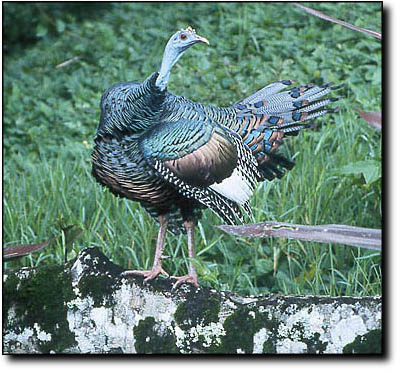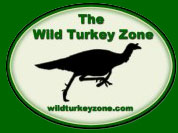| Background
 The
Ocellated Turkey, called Cutz by the Maya, is a wild
bird similar to the domestic turkey. It has never
been domesticated and has even survived the radical
transformation of its habitat. The Ocellated Turkey
is a game bird appreciated for its flavor and its
wide, tender breast. It is large enough to feed an
entire family and in some areas has been over-hunted;
though fortunately, that is not the case everywhere. The
Ocellated Turkey, called Cutz by the Maya, is a wild
bird similar to the domestic turkey. It has never
been domesticated and has even survived the radical
transformation of its habitat. The Ocellated Turkey
is a game bird appreciated for its flavor and its
wide, tender breast. It is large enough to feed an
entire family and in some areas has been over-hunted;
though fortunately, that is not the case everywhere.
Physical
Characteristics
The Ocellated Turkey
has tail feathers with the green-blue 'eyespots' edged
in a metallic bronze color, from which its name is
derived (ocelli or 'eye' in Latin). In addition to
red warts, the blue head of the male bird sports a
fleshy, drooping protuberance that is reddish-orange
in color. The Ocellated turkey lacks the tuftlike
beard found on the chest of male and some females
of the common wild turkey found in the U.S. but does
have very impressive spurs. Its body weight is much
smaller than the birds in the U.S. with males averaging
about 12 lbs. and females 6-7 lbs.
The Cutz has powerful
wings, yet only maintains flight for short distances.
It forages on the ground for insects, seeds, fruit
and other food, avoids the deep jungle by sticking
to open spaces like cornfields, marshes and the forests'
edge.
The bird is polygamous,
and inflates its plumage and struts like a peacock
to attract mates. Females lay from 11 to 20 brown-spotted,
cream-colored eggs that are incubated for approximately
four weeks.
Habitat
and Range
The Cutz survives in
large numbers throughout the Mundo Maya, and is in
no danger of extinction in the near future. Its range
includes the Yucatan Peninsula, limited areas of the
states of Tabasco and Chiapas, and the Central American
countries of Belize and Guatemala.
Its preference for open fields and
second-growth scrub works in its favor, since the
bird ends up settling in areas abandoned by man-where
it can live undisturbed.
|

